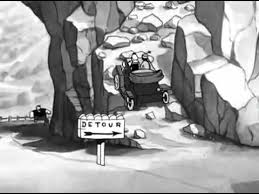According to L&H biographer Randy Skretvedt, One Good Turn came about because Stan’s real-life daughter Lois was afraid of “Uncle Ollie,” so Stan did this movie to show that his on-screen persona could stand up to Ollie whenever necessary. While there is some satisfaction in seeing the oft-bullying Ollie get his for a change, it leaves the movie rather open-ended.
(Major spoiler alert follows.) The story is that “victims of the Depression” Stan and Ollie have begged a meal from an old lady (Mary Carr) whom they mistakenly believe needs $100 to keep from being evicted. (They didn’t know that she was rehearsing for a community-theater play.) After a drunk (an uncredited Billy Gilbert) mistakenly shoves his loaded wallet into Stan’s pocket, Ollie discovers the wallet and assumes the worst about his pal, dragging him kicking and screaming back to the old lady to “make a full confession.” When Ollie learns the truth, he tries to tie-twiddle his way out of his “slight faux pas,” only to feel the full wrath of Stan’s vengeance.
The concept is cute, but the execution is troubling. Earlier at the free lunch provided by the lady, Stan absent-mindedly pours coffee into Ollie’s lap. To get back at Stan, he grabs an entire pitcher of coffee cream and pours it onto Stan’s lap. The laugh from this gag is diminished when one realizes they’re having a food fight at the expense of a generous woman.
Similarly, at the film’s climax, Stan corners Ollie in a garage (presumably also the old lady’s) and venomously chops it down so that the roof will fall on Ollie. Again, one can’t entirely enjoy Stan’s revenge while knowing that this poor lady might indeed need the $100 to clean up the destruction caused by Stan.
One Good Turn has some funny gags – especially at the beginning, when Stan inadvertently destroys the tent they were using to live in. But in that instance, the only persons they were harming were themselves. L&H biographer Scott MacGillivray wrote that when Stan and Ollie ripped up their wartime ration cards (in a scene in Jitterbugs), audiences groaned at the loss of what was then a sizable commodity. One wonders what Depression audiences must have thought of Stan and Ollie wreaking havoc on an innocent old woman.











